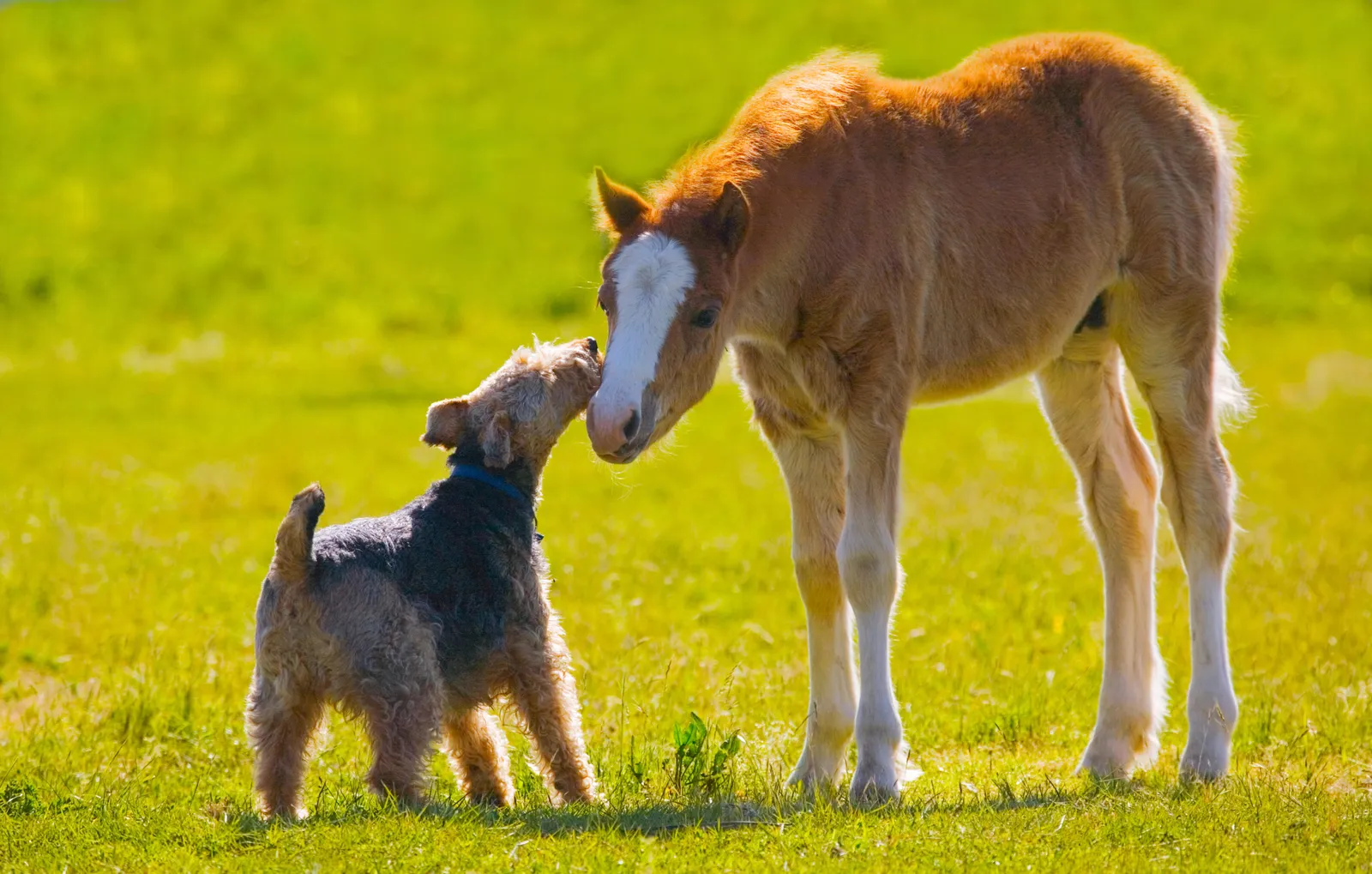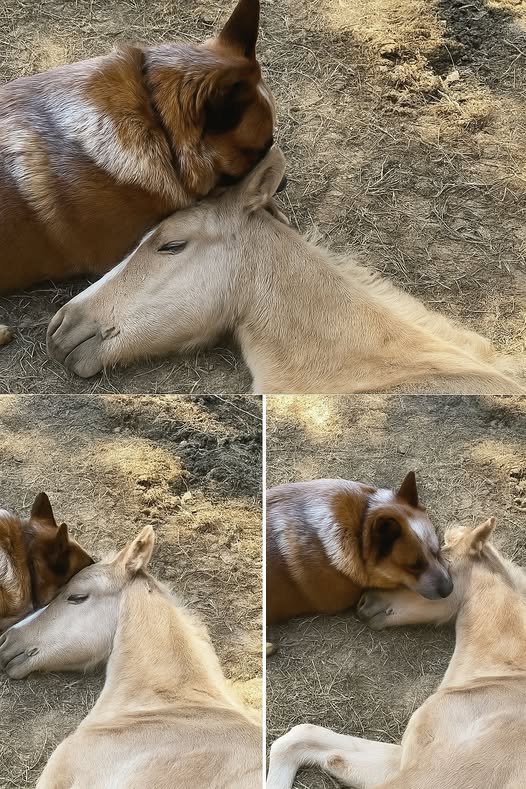In the quiet rolling fields of a family farm, a fragile life began again. When a newborn foal named Charlie lost his mother unexpectedly, the farmers feared he would not survive the long nights ahead. Orphaned foals rarely thrive without maternal care—they need warmth, guidance, and a steady presence to mimic their mother’s comfort.
But fate had other plans.
From across the pasture came Daisy, the family’s gentle Border Collie. Drawn by the foal’s soft cries, she approached not as a herding dog but as something far more nurturing. Nuzzling him with care, she refused to leave his side. In the days that followed, Daisy guided Charlie to water, nudged him to stand, and even rested near him at night to share her warmth.
The farmers watched in awe as this unlikely pair formed a bond that would change both their lives. It was as if nature had written its own story of compassion—one that blended instinct, emotion, and perhaps something beyond explanation.
A Story of Survival and Connection
Charlie’s early days were uncertain. Foals depend heavily on their mothers not just for nutrition but for social learning and emotional regulation. Without that maternal presence, many become anxious or withdrawn. Yet Daisy, though of a completely different species, seemed to understand exactly what the foal needed.
She comforted him through gentle touch and movement, often walking beside him in the same steady rhythm a mare would use to reassure her young. When Charlie hesitated to explore, Daisy encouraged him, her tail wagging in patient persistence. Their connection became so strong that the foal followed her everywhere—across fields, through gates, and even back to the barn each evening.
This story of interspecies companionship is not just heartwarming—it reveals something profound about empathy in the animal world. It challenges the limits of what we believe instinct can achieve and opens a window into the emotional intelligence shared by species that, at first glance, seem worlds apart.

Historical and Cultural Perspectives on Animal Bonds
Throughout human history, stories of cross-species friendship have captivated our imaginations. In ancient mythology, animals often symbolize virtues like loyalty, wisdom, and protection—and sometimes, they even bridge worlds.
In Celtic folklore, dogs were seen as guardians between life and nature, guiding souls and protecting livestock. Horses, by contrast, represented strength, nobility, and freedom. A story like Daisy and Charlie’s would have been viewed as a sacred harmony between two spiritual protectors—one of the land and one of the heart.
In Japanese Shinto tradition, animals embody divine spirits known as kami, and their connections with one another are seen as reflections of natural balance. A dog showing compassion toward another species might be interpreted as a sign of universal harmony.
Even in Indigenous American storytelling, the concept of kinship among animals is central. Wolves, horses, and birds are often described as members of one great family of life. The belief that compassion can transcend species boundaries has long been part of humanity’s understanding of the natural world.
So, when Daisy extended her care to Charlie, she wasn’t simply displaying learned behavior—she was acting out a truth as old as storytelling itself: love is a language that all living beings understand.

The Science of Empathy Between Species
Modern science offers fascinating insight into what drives these bonds. Studies in animal behavior and neuroscience have shown that many species possess the biological foundation for empathy and care.
Researchers at Emory University and Cambridge University have discovered that mammals, including dogs and horses, share similar oxytocin responses—the same hormone that fosters social bonding in humans. When animals engage in nurturing or affectionate behavior, their brains release oxytocin, reinforcing trust and emotional connection.
This hormone-driven connection helps explain why Daisy’s caregiving instincts seemed so maternal. Her empathy wasn’t an illusion; it was a measurable physiological response.
In addition, mirror neurons, specialized cells in the brain that activate both when performing an action and when observing another do so, may allow animals to “feel” the emotions of others. When Daisy saw Charlie struggling, these neurons could have triggered her instinct to comfort and assist—similar to how a mother dog responds to her puppies’ distress.
Interestingly, horses also exhibit deep emotional awareness. Studies published in Scientific Reports (Nature Journal, 2016) show that horses can recognize human facial expressions and remember emotional experiences. They are also sensitive to tone and energy—meaning Charlie likely sensed Daisy’s calm and compassionate demeanor, reinforcing his trust in her.
Together, their biological responses created a feedback loop of mutual comfort, one that transcended species lines.

Lessons from the Field — Real-Life Cross-Species Bonds
While Daisy and Charlie’s story is extraordinary, it’s not entirely unique. Around the world, countless examples of interspecies friendships have emerged, often surprising scientists and inspiring animal lovers alike.
In Kenya, a tortoise named Mzee famously bonded with an orphaned hippo, Owen, forming a relationship that defied both logic and biology. The tortoise became a calming influence for the young hippo, who followed him everywhere.
In the United States, a golden retriever once “adopted” a litter of orphaned kittens, grooming and sleeping beside them as though they were her own pups.
These connections often arise in moments of shared vulnerability. When one animal senses distress in another, the boundaries of instinct blur, and empathy takes over. What might begin as curiosity transforms into companionship—and sometimes, lifelong friendship.
Such examples remind us that empathy is not uniquely human. It is an evolutionary advantage shared across species, reinforcing cooperation, survival, and emotional resilience.
Myths, Meaning, and the Heart of Compassion
From a mythological perspective, Daisy and Charlie’s story mirrors archetypes of nurturing and rebirth found throughout literature. The image of one creature caring for another outside its kind often represents renewal and unity.
In ancient Egyptian mythology, the goddess Isis was known for her boundless compassion, not limited by form or boundary. Her love symbolized the restorative power of connection.
Similarly, in Hindu philosophy, compassion (karuṇā) is viewed as a universal energy—an expression of the divine that exists in all living beings. When Daisy extended care to Charlie, it was as if she tapped into that timeless current, demonstrating that love itself is nature’s most unifying force.
Cultural anthropologists note that such stories endure because they mirror what we hope for in ourselves: to reach beyond fear, difference, and self-interest. The bond between Daisy and Charlie reminds us that empathy is not learned solely through words but through presence, patience, and quiet understanding.

The Psychology of Love and Healing
Animal-assisted therapy has shown similar emotional effects between species. Programs pairing rescue animals with humans recovering from trauma have demonstrated significant improvements in mood and social behavior.
When dogs comfort humans—or, in this case, a foal—their behavior reduces cortisol (the stress hormone) and increases serotonin, fostering emotional balance. This mirrors the psychological healing humans experience when offering or receiving kindness.
Behavioral experts believe that Daisy’s nurturing instincts may have provided Charlie with a secure base, allowing him to develop confidence. Just as human infants form attachment bonds that shape emotional health, animals also benefit from stable companionship during early development.
This connection reveals that empathy and attachment are not abstract emotions but tangible biological mechanisms rooted in our shared evolutionary history.
The Eternal Lesson of Daisy and Charlie
Months after Daisy first cared for the orphaned foal, Charlie grew strong enough to join the other horses in the pasture. The farmers watched proudly as he galloped freely, a picture of vitality and independence.
Yet, even as he integrated with his herd, he never forgot his unlikely guardian. Daisy would often wait by the fence, her gaze following him with the calm satisfaction of one who knows her work is done. Charlie would trot over, lowering his head in greeting, as if to say thank you.
Their friendship endured—not out of dependency, but respect and affection. It was a living reminder that family isn’t always defined by blood or species. Sometimes, it’s chosen through compassion.

Conclusion: What Daisy and Charlie Teach Us About Humanity
At its heart, the story of Daisy and Charlie is more than an animal tale—it is a reflection of the values that define us as humans. It reminds us that compassion is not confined by biology, and that empathy often flourishes in the most unexpected places.
Myth and science converge here, telling the same truth through different languages: love is both ancient and measurable, instinctive and sacred.
When we see a dog comforting a foal, or a person rescuing an animal in need, we are witnessing one of nature’s most powerful forces at work—the drive to connect, to care, and to heal.
Such stories fuel our curiosity, urging us to ask deeper questions about emotion, consciousness, and the invisible threads that bind all living beings. Perhaps that curiosity is itself a form of love—a desire to understand, to reach across boundaries, and to recognize ourselves in the eyes of another.
Because in the end, whether we walk on two legs or four, the lesson remains the same: compassion knows no boundaries, and love always finds a way.
Sources
- American Veterinary Medical Association – Animal Behavior and Bonding Studies
- Emory University Department of Psychology – Oxytocin and Emotional Processing in Dogs
- Scientific Reports (Nature, 2016) – Horses’ Sensitivity to Human Emotion and Expression
- National Geographic – Cross-Species Friendships and Animal Empathy
- Smithsonian Magazine – Cultural Symbolism of Animals in World Mythology
- Cambridge University Press – The Evolution of Empathy in Mammals
